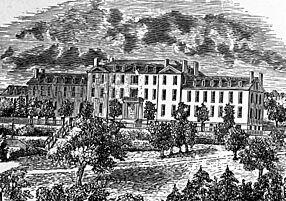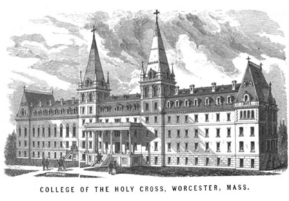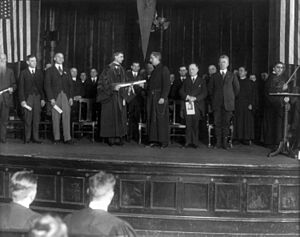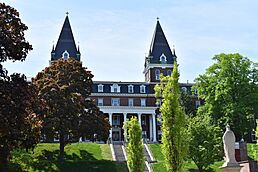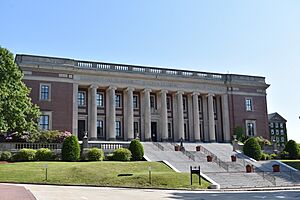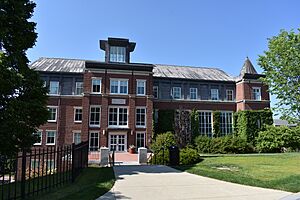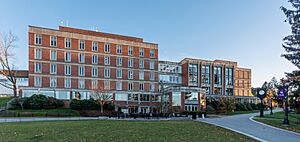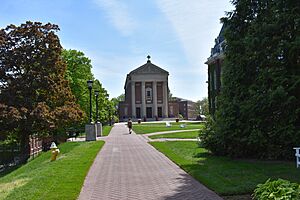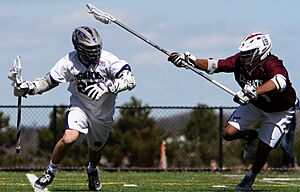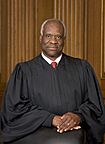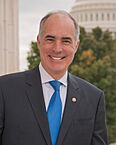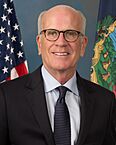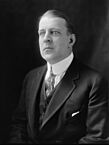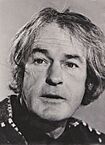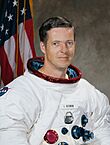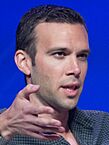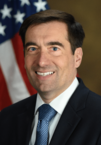College of the Holy Cross facts for kids
 |
|
| Latin: Collegium Sanctae Crucis | |
| Motto | In hoc signo vinces (Latin) |
|---|---|
| Type | Private liberal arts college |
| Established | October 1843 |
| Founder | Benedict Joseph Fenwick Thomas F. Mulledy |
|
Religious affiliation
|
Catholic (Jesuit) |
|
Academic affiliations
|
|
| Endowment | $1.109 billion (2024) |
| President | Vincent Rougeau |
|
Academic staff
|
350 |
| Undergraduates | 3,219 |
| Location |
,
,
U.S.
42°14′21″N 71°48′30″W / 42.23917°N 71.80833°W |
| Campus | Suburban, 174 acres (70 ha) |
| Colors | Purple and White |
| Nickname | Crusaders |
|
Sporting affiliations
|
NCAA Division I –
|
 |
|
|
College of the Holy Cross
|
|
| Lua error in Module:Location_map at line 420: attempt to index field 'wikibase' (a nil value). | |
| Location | Fenwick and O'Kane Halls, surrounding landscaping |
| Area | 2.6 acres (1.1 ha) |
| Built | 1843 |
| Architect | Lamb, Capt. Edward, et al. |
| Architectural style | Classical Revival, Gothic, Second Empire |
| MPS | Worcester MRA |
| NRHP reference No. | 80000491 |
| Added to NRHP | March 5, 1980 |
The College of the Holy Cross is a private Jesuit liberal arts college in Worcester, Massachusetts. A liberal arts college is a school where students study a wide variety of subjects, like history, science, and art. It was started in 1843 by Benedict Joseph Fenwick and Thomas F. Mulledy with help from the Society of Jesus, a Catholic religious group known for education. Holy Cross was the first Catholic college in New England.
About 3,000 undergraduate students attend Holy Cross. They live on campus and can choose from 64 different subjects to study. The college's 174-acre campus sits on a hill, giving it the nickname "The Hill." It has a great view of the city of Worcester.
Holy Cross has one of the largest endowments (money saved and invested to support the school) of any liberal arts college in the U.S. Its sports teams are called the Crusaders and they compete in NCAA Division I.
Many famous people have graduated from Holy Cross. These include Dr. Anthony Fauci, the former Director of the National Institute of Allergy and Infectious Diseases, and Clarence Thomas, a justice on the U.S. Supreme Court. The college has also produced many award-winning actors, writers, and Olympic athletes.
Contents
History
How the College Began
The College of the Holy Cross was founded by Benedict Joseph Fenwick, the second Catholic bishop of Boston. He wanted to start a Catholic college in Boston, but the city's leaders at the time made it difficult. Bishop Fenwick decided to build the college 45 miles away in Worcester, where he felt the school could operate more freely.
He was very excited about the location, writing:
Next May I shall lay the foundation of a splendid College in Worcester... It will stand on a beautiful eminence & will command the view of the whole town of Worcester.
The land for the college, called Mount Saint James, was bought from a priest named James Fitton on February 2, 1843. Bishop Fenwick named the college after his main church, the Cathedral of the Holy Cross.
Early Years

The school opened in October 1843 with only six students. Within three years, there were 100 students. At first, the school was more like an elementary and high school, but it later grew into a college.
The first class graduated in 1849. The top student was James Augustine Healy, who later became the first African-American bishop in the United States.
In 1852, the main building, Fenwick Hall, was destroyed in a fire. People raised money to rebuild it, and the college reopened in 1853. For many years, the state of Massachusetts refused to give the college an official charter (a document that allows it to operate). This was partly due to anti-Catholic feelings at the time. Finally, on March 24, 1865, Governor John Albion Andrew granted the charter.
Modern Times
During World War II, Holy Cross was part of the V-12 Navy College Training Program. This program helped students become officers in the U.S. Navy.
In 2000, Michael C. McFarland became the college's president. He was followed by Philip L. Boroughs in 2011. In 2021, Vincent Rougeau became the new president. He is the first president in the college's history who is not a priest and the first Black president.
In 2018, the college discussed changing its "Crusader" mascot because of its connection to the historical Crusades. The school decided to keep the name but changed the mascot image from a knight to a purple shield.
Campus
The 175-acre Holy Cross campus is a registered arboretum, which means it has a special collection of trees. It is located on a hill called Mount Saint James, which gives students a great view of Worcester.
The campus has 37 buildings. The oldest part of campus includes Fenwick Hall and O'Kane Hall, which has a large clock tower. Near these buildings are three bronze statues. This historic area is listed on the National Register of Historic Places.
Other important buildings include the Dinand Library and the Hogan Campus Center. The Anthony S. Fauci Integrated Science Complex, named in 2022, is home to the science departments. A plaza outside Smith Hall honors seven Holy Cross graduates who died in the September 11, 2001 attacks.
The beautiful St. Joseph Memorial Chapel is at the eastern end of campus. The newest major building is the Prior Performing Arts Center, which opened in 2022. This $110 million building provides a modern space for art, music, and theater on campus.
Libraries
Holy Cross has four libraries. The main one is Dinand Library, which holds over 600,000 books and other materials. It opened in 1927. Its large, beautiful reading room has a high ceiling with gold trim and large chandeliers.
The other libraries are for specific subjects:
- Fenwick Music Library: Has collections of music scores and recordings.
- O'Callahan Science Library: Serves the science and math departments.
- Rehm Library: A quiet space for studying religion and ethics.
- Visual Resources Library and Worcester Art Museum Library.
Dinand Library also contains the College Archives. The archives store important records, photos, and publications from the college's history. It also holds the papers of famous people, including the medals of Joseph T. O'Callahan, a Navy chaplain who received the Medal of Honor.
Protecting the Environment
Holy Cross is working to protect the environment. In 2007, the college promised to reduce its carbon emissions (gases that can harm the planet). The school's goal is to be "carbon neutral" by 2040, meaning it won't add any extra carbon to the atmosphere.
To help reach this goal, the college has made several changes. It has Zipcar car-sharing on campus to reduce the number of cars. The main dining hall also stopped using trays, which saves water and reduces food waste.
Academics
Holy Cross is known for its strong programs in subjects like political science, economics, chemistry, and classics (the study of ancient Greece and Rome). To graduate, students must take a wide range of classes in the arts, sciences, and humanities.
The most popular majors for students graduating in 2021 were:
- Economics
- Psychology
- Political Science & Government
- English Language and Literature
- Biology/Biological Sciences
- History
Volunteering and Social Justice
Holy Cross encourages students to help others and work for social justice. Many graduates serve in the Jesuit Volunteer Corps, a group that helps communities in need.
The largest student group on campus is Student Programs for Urban Development (SPUD). It has over 600 students who volunteer in more than 45 community service programs around Worcester. Other programs allow students to help communities in the Appalachian Mountains or learn about justice issues in other countries.
Rankings and Reputation
Holy Cross is considered one of the top liberal arts colleges in the United States. U.S. News & World Report ranked it 27th among liberal arts colleges in the U.S. for 2023. It is also known as a top producer of Fulbright scholars, who receive grants to study in other countries.
In 2016, the book The Hidden Ivies, 3rd Edition: 63 of America's Top Liberal Arts Colleges and Universities described Holy Cross as a "Hidden Ivy." This means its academics are as good as those at famous Ivy League schools.
Student Life
Living on Campus
Most students live on campus in residence halls (dorms). After their first year, students enter a housing lottery to choose their rooms. Seniors have the option to live in apartment-style housing, which is very popular. These apartments have their own kitchens, bathrooms, and living rooms.
Student Groups
Since Holy Cross is not in a major city and does not have fraternities or sororities, social life is centered around campus events and student organizations.
Some popular student groups include:
- Student Publications: Students publish a weekly newspaper called The Spire and other journals.
- WCHC-FM 88.1: The student-run radio station broadcasts music and sports games.
- Campus Activities Board (CAB): This group plans fun events for students, especially on weekends.
- 'Student Government Association (SGA): Represents students and helps fund campus activities.
- Holy Cross Goodtime Marching Band: Formed in 1845, it is one of the oldest college bands in the country.
College Symbols
Color
The school color is purple. One story says the color was inspired by the royal purple used by the Roman emperor Constantine the Great.
College Seal
The college seal includes an open book (for learning) and a gold cross (for faith). The book has the college's motto, In Hoc Signo Vinces, a Latin phrase meaning, "By this sign you shall conquer." The shield also has the emblem of the Society of Jesus and symbols from the family crest of Bishop Fenwick.
Mascot
Holy Cross's sports teams are called the Crusaders. The name was first used in 1884. In 2018, the college stopped using a knight as its mascot image. The main logo is now a purple shield with an interlocking "HC."
Athletics
Holy Cross has 27 varsity sports teams that compete at the NCAA Division I level. The teams, known as the Crusaders, are part of the Patriot League.
The main sports facilities are Fitton Field for football, the Hart Center for basketball and ice hockey, and the Linda Johnson Smith Soccer Stadium.
Holy Cross has a proud sports history. It is one of only eight schools to win national championships in both baseball (1952) and basketball (1947). In 2016, the men's basketball team made it to the NCAA tournament and won its first tournament game since 1953.
Alumni
-
Anthony Fauci,
Director of the National Institute of Allergy and Infectious Diseases -
-
-
Patrick Francis Healy,
29th President of Georgetown University -
-
Joseph P. Kerwin,
NASA Astronaut for Skylab 2 -
Bob Wright,
President, CEO, and Chairman of NBC -
John Demers,
U.S. Assistant Attorney General
Holy Cross has over 38,000 alumni (graduates) around the world. They have become leaders in government, law, business, science, and the arts.
Some notable alumni include:
- Clarence Thomas, an Associate Justice of the U.S. Supreme Court.
- Dr. Anthony Fauci, a famous immunologist and former head of the National Institute of Allergy and Infectious Diseases.
- Bob Cousy and Tom Heinsohn, members of the Basketball Hall of Fame who played for the Boston Celtics.
- Jon Favreau, former Director of Speechwriting for President Barack Obama.
- Bob Wright, former Chairman and CEO of NBC Universal.
- Joseph Murray, who won the 1990 Nobel Prize in Medicine.
- Edward P. Jones, who won the 2004 Pulitzer Prize for his novel The Known World.
- Billy Collins, who was the Poet Laureate of the United States from 2001 to 2003.
- Ann Dowd, an Emmy-winning actress.
See also
 In Spanish: College of the Holy Cross para niños
In Spanish: College of the Holy Cross para niños
- List of Jesuit sites
- List of presidents of the College of the Holy Cross
- National Register of Historic Places listings in eastern Worcester, Massachusetts


